When I first started my research, I was a bit disappointed to find many false facts and incorrect statements about ladybugs, so I felt I had to put the record straight as much as I could with a ladybug frequently asked questions page.
So I’ve compiled a big list of the most common Ladybug questions I get asked by children and adults, plus some others, and which I’ve had to find out myself previously – so I’ve done my full research on this!
I’ll update this as and when I’m able to, so it’s always as up-to-date as possible with the latest facts and information about Ladybugs.
However, if you want to get more in-depth knowledge, then do check out my Article Ladybugs – a Complete Guide, which goes into much more detail about every aspect of a ladybug’s life. So if you have a science project then you may want to head there!
Here we go then, all the answers to your Ladybug Questions…
1. Are There Different Kinds of Ladybugs?
Yes, there are 5000 known varieties of Ladybugs in the world, inhabiting most of the world in fact (almost everywhere except the Arctic, Antarctic, and a few extreme northern continental areas. Of these, 500 types are known to inhabit North America alone.
They come in all different colors, some with spots, some with stripes, and some with no markings at all. The brighter the color they are, the more toxic they can be to other insects.
2. Do Ladybugs Sleep?
Ladybugs do not ‘sleep’ in the way that humans do. They enter into a state of torpor, most commonly at night and when in hibernation. During this, they rest deeply.
Their body uses around 1/10th of its energy whilst in this state. During hibernation, this is called Diapause. Ladybugs live off fat reserves whilst in diapause.
3. How Can You Tell How Old a Ladybug Is?
Counting the spots as a way to gauge a ladybug’s age is actually a MYTH. Some Ladybugs have 24 spots but are certainly not 24 years old. The spots merely denote the species of a ladybug. Here’s more detail about ladybug spots meaning.
Most Ladybugs live for around 1-2 years, some up to 3 years. As the Ladybug gets older its spots fade. The only way to discern roughly how old it is would be to gauge how faded the spots were.
4. Are Ladybugs Helpful or Harmful?
Ladybugs are not harmful to Humans at all unless you’re allergic to their tiny bites. They can exude a foul smell to ward off predators and are even poisonous to some predators.
You would have to eat a great many of them before you became ill. Find out more about how the five ways Ladybugs protect themselves.
5. Can I Keep a Ladybug as a Pet?
Yes, you can, but I would say only keep them for a short amount of time – for study purposes only. Then, let them go back to the wild where they need to be in order to survive long term. There’s a great little starter kit on amazon for your kids to help them raise and study ladybugs. There’s no greater lesson than seeing and following it firsthand!

6. Is a Ladybug a Bug?
Ladybugs are actually Beetles. Bugs use needle-like mouthparts and mainly consume liquids. Beetles have jaw-like mouthparts and chew their food.
Both bugs and beetles fall under the category of insects. Yes I know… even though we call them Ladybugs – they are in fact Beetles!
7. Why Is a Ladybug Called a Ladybug?
For this, we go all the way back to England during the middle ages. Bugs – main aphids were heavily destroying crops. The Farmers, being devout Catholics, prayed to the Virgin Mary for help.
Then along came a swarm of Ladybirds who ate all the aphids and saved the crops … Hoorah, they cried! From that day onward they were named ‘Beetle of our Lady’ – after the Virgin Mary.
Today, they’re called Lady Beetles, or Ladybugs in America, whereas around Europe they’re called by many names.
8. Do Ladybugs Eat Grass?
Feeding Ladybugs grass will not help. Whilst there are some fungal and mushroom-eating Ladybugs, as well as some plant-eating Ladybugs.
Most Ladybirds are predators that hunt down soft-bodied insects like aphids. Ladybugs will on occasion eat other things like nectar. Find a list of what Ladybugs eat here
9. Can Parrots and Budgies Eat Ladybugs?
As with most birds, if they eat one Ladybug it will not usually pose a problem. If the taste is not to their liking then they will know not to eat another.
Any bird that looks at a Ladybug and ignores it has likely already tried and disliked it. The bright colors of the Ladybug will deter most birds anyway. See more information here on What Eats Ladybugs.
10. How Do Ladybugs Help The World?
Ladybugs are considered a beneficial insect. Meaning they’re a natural form of pest control within gardens and agriculture. Aside from a few herbivore Ladybugs, most are voracious predators of other small-bodied insects such as aphids and mealworms. Find out more about Why Ladybugs Are Important.
11. Can You Give Me More Information About Ladybug Life for My Child’s Ladybug Science Report?
Yes, absolutely, I’d love to help. Here are some of the resources that will help your child. My Ladybug Life Cycle article will tell you more about the four stages.
My Ladybug Anatomy Article will explain how they work. Then, to go that extra mile, I’d suggest you run your own Ladybug study class by raising Ladybugs with them using this great kit. I hope that helps? Do let me know how you get on!
12. What Do Dreams About Ladybugs Mean?
Ladybugs in dreams can mean lots of things depending on what happens in the dream. Anything from good luck, to protection, to children, to marriage. Slightly big topic to cover here so have a read of my article on What Ladybugs Mean – in Love, Luck, Signs, and Symbols – with a helpful dream chart.
13. How Do Ladybugs Eat?
Ladybugs are not actually bugs, they’re classed as beetles. Bugs mainly consume liquids via needle-shaped mouthparts. Whereas Beetles have mandibles and chew their food. Ladybugs eat with their mouths and chew – mainly insects.
14. What Do Ladybugs Look Like?
Ladybugs are small spherical-shaped beetles from 0.4” to 0.7” long. They have a hard shell called an Elytra which covers and protects their delicate wings.
The Elytra can come in many bright colors and usually has some form of black spots, stripes, or other markings. Like all beetles, they have 6 legs, a mouth, and 2 eyes. Although a Ladybug’s eyesight is not good, it relies on its antenna and its feet to sense its prey.
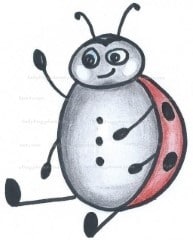
Did You Know
A gift of a Ladybug is said to symbolize protection for New Born Babies.
Show me more signs, symbols, and meanings for Ladybugs
16. What Do The Colors Mean on a Ladybug?
Largely speaking the colors of Ladybugs only refers to their variety, of which they prefer to mate with. Other than that, the vibrant color of a ladybug denotes how toxic it is to predators. So for example, a Bright Red Ladybug may taste slightly worse than a grey one.
17. In What Habitat Do Ladybugs Live?
Ladybugs live in temperate climates below 55°F, which includes most of the world. Mainly dwelling in forests, gardens, grasslands, and fields. In winter they find warmer places, mainly locally in order to hibernate, but can be found to hibernate in people’s homes.
18. Is There Such Thing as a Black Ladybug?
Ladybugs come in many types and colors, The Chilocorinae are a subfamily of ladybugs in the family Coccinellidae. They are simply a different color but have all the same life cycle, habitat, and diet habits as other Ladybugs in the same family of insects. Black Ladybugs are not considered rare.
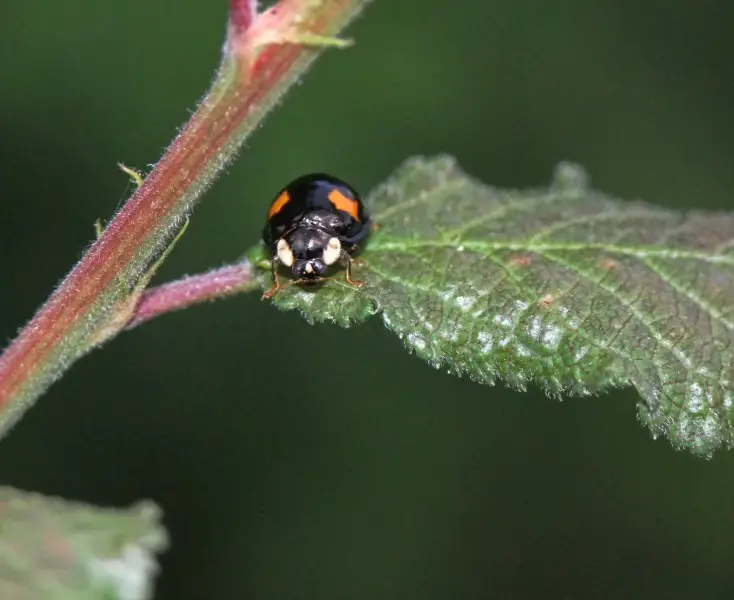
19. What Are Ladybug Babies Called?
A baby ladybug that has just hatched from a Ladybug egg is called a Larva, the plural (more than one) would be called Larvae. At this stage, they resemble little alligators. After a couple of weeks, they will turn into the Pupa stage. See the full Life-Cycle here.
20. How Many Spots Do Ladybugs Have?
The number of dots on a Ladybug varies significantly. There are Ladybugs with no spots, many native to the USA and Europe have 2 or 7 spots.
Some others have as many as 24 spots which are the most found. Some instead are striped or have other shapes. While we’re here, the number of spots does NOT denote the age of the Ladybug. Here’s what the spots mean.
21. What Are the Main Characteristics of a Ladybug?
An insect of around 5000 varieties worldwide, of which about 500 are found in the USA. They are classed as an insect, they have a hard outer shell with wings beneath. They have a 4 Stage Life Cycle of Egg, Larva, Pupa, and Adult. Mostly carnivores hunt soft-bodied insects such as Aphids.
22. Is There Such Thing as a Purple Ladybug?
Unfortunately, however wonderful it may be, purple Ladybugs do not exist. It was a story made up some time ago and very clever use of Photoshop. If you find this to be different then please send me a video and I can verify it further. Otherwise, don’t be fooled!

23. How Many Colors Do Lady Beetles (Ladybugs) Come In?
They can be found in a multitude of colors and markings. The most common are those that are orange through to red in color. Other common types are black, white, yellow, and orange.
Though they have been reported in other colors such as purple and green or been confused with other insects. The coloration acts as a warning to predators, known as ‘aposematic coloration.’ There’s even a blue ladybug here.
24. Do Ladybugs Sleep on Their Back?
No, not generally. if a Ladybug is on its back there is more chance this is because it is dead or dying rather than alive or sleeping. The only other time you might see a Ladybug on its back is possibly when hibernating in groups. See my article on whether a Ladybug is dead, dying, or hibernating, and what to do!

Quick Quiz…
How Fast Can a Ladybug Fly?
12 mph
23 mph
37 mph
Here’s the answer
25. Is It Called Ladybug or Ladybird?
In Europe it’s called many different names, in the UK it’s commonly called a Ladybird. In North and South America it’s called a Ladybug, or Lady Beetle. If you want, you can find out ALL the names they are known as.
26. Is an Orange Ladybug an Actual Ladybug?
Indeed an orange Ladybug is a Ladybug, but beware, there are over 5000 varieties of Ladybug. However, there are also many imitating insects as well as other orange-colored similar insects. If you’re not sure then provide a description in the comments below and I’ll help identify it for you.
27. How Can You Tell a Male Ladybug from a Female Ladybug?
To the naked eye, you won’t be able to. It requires an entomologist with a microscope to properly identify a male from a female.
You can gauge if it’s male or female as the females are generally larger than their male counterparts of the same variety. Or if they’re mating, then it’s the male on the back. Here are the other ways to tell males from females.
28. Can Ladybugs Kill Bed Bugs?
Not really, they probably could kill a bed bug, provided they can see them. But bed bugs are usually in homes and Ladybugs are mostly outside. Plus bed bugs are largely hidden beneath your covers and come out at night.
Whereas Ladybugs are diurnal which means they hunt during daylight hours. Finally, bed bugs are really small, it’s almost not worth the effort of a Ladybug. This is how Ladybugs see the world, so they may not even be able to see bed bugs, but they might smell them.
29. What If I Accidentally Kill a Ladybug
Ah, oh dear, well then you need to read this article!
30. What Is the Ladybug’s Ecological Niche?
Pest control. Ladybugs are insatiable hunters of soft-bodied insects such as Aphids or mealworms. For this reason, they help keep pest numbers at an optimum balance both in the garden and within agricultural crops. They are farmers’ and gardeners’ friends for sure.
31. Can Two Different Ladybug Varieties Mate to Produce a New Species?
Ladybugs utilize a ‘lock and key’ combination for mating with their own variety. Although mating is possible between different varieties – and has been seen to happen. It is unlikely to work, if it does, then it’s unlikely to produce a further variant. In most cases, the female will denote the variety of the new Ladybug.
32. What Does a Ladybug Landing on You Mean?
A Ladybug Landing on you can mean a lot of things. From good luck to a marriage. For a list of Ladybug Meanings when they land on you, and for Ladybugs in dreams too, read this article What Ladybugs Mean – in Love, Luck, Signs, and Symbols – with Chart

33. Do Ladybugs Kill Leaf Bugs?
No, mainly due to size. The average Ladybug length is around 0.4 to 0.7 inches. The Leaf bug weighs in between 1.2 to 3.9 inches.
If they were baby leaf bugs then perhaps. But generally, they’re way too big for a Ladybug to tackle and Ladybugs do not hunt in packs. So the prey is just too large. Both can exist happily side by side, however.
34. What’s the Yellow Stuff Coming Out of The Ladybug?
If a Ladybug has landed on you, then you might have thought they pooped on you. In fact, they probably just allowed some toxins, in the form of their blood to leak out. It smells bad, and it would taste even worse – certainly to predators. This is called ‘Reflex Bleeding’ and is a common defense mechanism for Ladybugs.
35. Why Do Ladybugs Lie on Their Backs Before Dying?
Often when beetles of many types are on the verge of dying, either writhing around or just plain becoming disoriented, they can lose their sense of balance and can easily tip over. Sad, but true. To know if a Ladybug is dead, dying, or just plain hibernating and what to do – check my article here,
36. Can a Ladybug Be Blue?
If you believe the photoshopped images around then you would be forgiven for believing it. The nearest a Ladybug can get to blue is the variety native to Australia called the ‘steelblue ladybird’ or Halmus chalybeus. Native to Australia it has a blue/green hue to its Elytra (outer shell). This is the nearest you would get to a blue ladybird/Ladybug
37. How Do You Make a Ladybug House?
There are a number of ways you can make a Ladybug house. The most common is with a 6’x1” plank of wood and a few basic tools. You can get the plans right here on ladybugplanet.com by clicking the following link to Ladybug House Plans. Or, you can get one from amazon – this one is my favorite!
38. How Do Ladybugs Move Around?
Ladybugs can fly pretty high and pretty fast. When not in flight they walk using all six legs, using their senses to search for potential food among plants and crops, or for a place to rest for the night or even for a mate.
39. Do Ladybugs Build a Nest? or Build a Home?
Actually no they don’t. Ladybugs move around freely. They rest at night and move on during the day. They often stay within a particular locale as long as there’s sufficient food present. During hibernation (diapause) they may gather in large groups to see out the winter together, sometimes thousands of them in one place, attracted by pheromones.
40. What Do Baby Ladybugs eat?
Baby Ladybugs are often described as mini alligators. They cannot fly, only walk. But they are hunters just like their adult counterparts and they hunt for and eat the same kind of food. They can eat up to 400 or more aphids before they turn into a pupa. See this identification article for larvae.
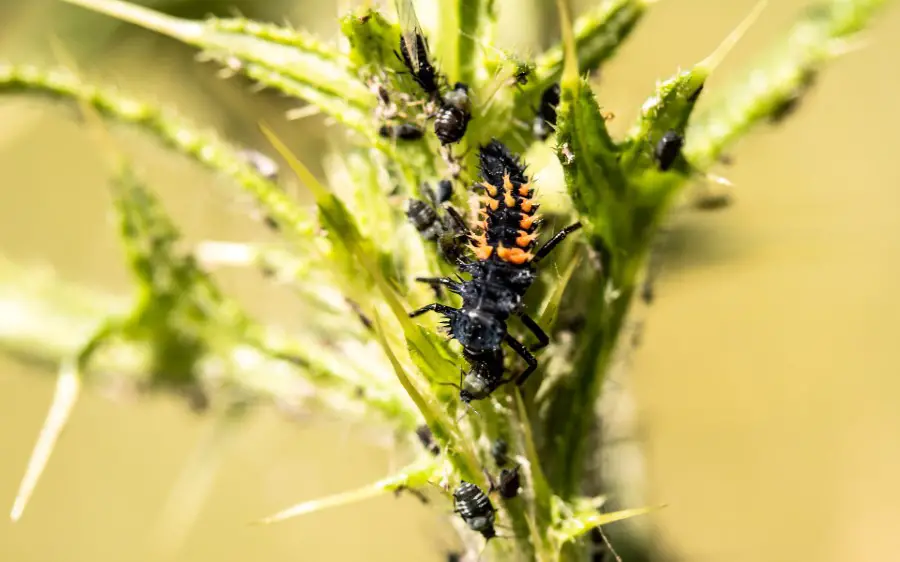
41. Can Ladybugs Bite a Human?
Yes, Ladybugs do bite humans.
And this one is the most likely to bite you.
Ladybugs bite either as one of their self-defense mechanisms – of which they have five forms. Or they mistakenly thought they were biting into a soft-bodied insect. Ladybugs do not carry poison or disease within their bite, so the only effect should be a minor irritation. Unless you have some allergy to the bite.
42. Why Are Ladybugs Beneficial?
Ladybugs, along with their Larva eat many insects that are considered pests to gardeners and farmers, thus keeping gardens and crops free from harmful insects.
43. How Do You Provide Water for Ladybugs?
Often Ladybugs will get sufficient water intake from eating their prey. However, they will need to take on extra water occasionally. There’s no need to drown Ladybugs with water. Just place a water-soaked paper towel nearby, and they’ll drink from that. In the wild, they drink morning dew or other droplets of water they find.
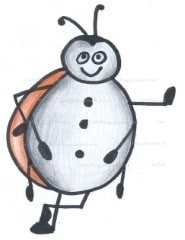
Did You Know…
A young Ladybug can Pause its growth whilst Hibernating?
Show me more surprising facts about ladybugs
44. Are Ladybugs Without Spots Poisonous?
There are no Ladybugs known to be poisonous to humans. You would either need to consume lots of them or be allergic to the bites they might inflict – which are mostly harmless. So, no, Ladybugs without spots are not poisonous.
45. What Are a Ladybug’s Biggest Threats?
Despite their protective shells and other protection mechanisms, some predators still eat them such as some birds, spiders, and toads. You can find the complete list of predators here. The largest threat is from man destroying natural habitats, and from other invasive Ladybug species such as the Asian Lady Beetle.
46. Do Ladybugs Pee and Poop?
Ladybugs do pee and poop. Just about all insects that consume food must release waste, due to their size you just might not be able to notice that much with the naked eye. Often what you think might be poop is actually a release of blood as one of the ways Ladybugs protect themselves. It has a foul odor and is known as ‘reflex bleeding.’
47. What Is an Asian Lady Beetle – Or Asian Ladybug?
The Asian Lady Beetle was originally a tree-dwelling Ladybug native to Asia. It was introduced into the US in 1978 in order to combat a growing pest problem – mostly aphids destroying crops. Since then, the Asian Lady Beetle has aggressively invaded much of the US, moving across to the UK, and now into Europe.
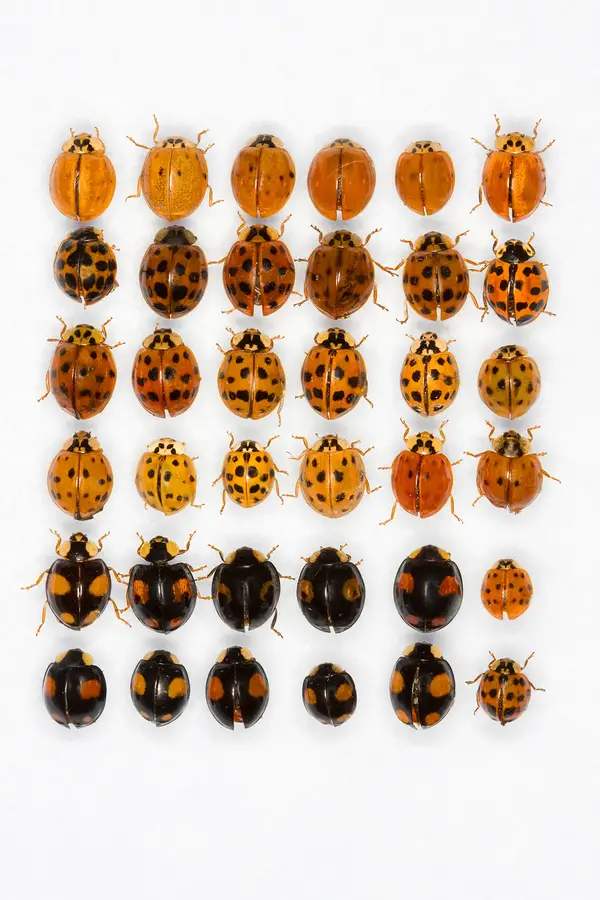
48. Are all Ladybugs Ladies?
You would be forgiven for thinking this, but no, there are ladybugs and ‘gentlemanbugs’ too if you want to think of it that way. You simply cannot tell the difference between the two with the naked eye. One way to gauge if it’s a male or female is that males tend to be slightly smaller than females of the same variety/coloring.
49. Where Are a Ladybug’s Wings?
Ladybugs have a protective outer shell called the Elytra, this hard shell is made of the same material that your fingernails are made of. This shell protects the delicate membrane wings that fold beneath them. For more amazing facts check out my Amazing Facts about Ladybugs Article.
50. Are Ladybugs Good Luck?
Ladybugs are considered to be good luck, this is in a variety of forms like if they land on you, or if you see one in a particular way, or in a certain place. There are lots of ways this can mean good luck, fortune, protection, and love. For more on this, and Ladybugs in dreams See What Ladybugs Mean – in Love, Luck, Signs, and Symbols.
51. Are Ladybugs Poison?
Ladybugs are not poison in themselves, and certainly not to humans. But, they can release a bad-smelling and bad-tasting fluid, in order to ward off would-be predators. They are toxic for some other small insects to eat. The vibrant color is also one of the five ways in which Ladybugs Protect Themselves.
52. Do Squirrels Eat Ladybugs?
Squirrels could easily eat Ladybugs if they chose to. However, they’re amongst the many creatures who have probably tried eating a Ladybug and found it to smell bad and taste just as bad! Given there are probably other better options to eat I don’t imagine Squirrels eat many Ladybugs.
53. Who Is a Ladybug’s Best Friend?
I’d like to say humans, but we are destroying their natural habitats and introducing different varieties together that wouldn’t normally mix that well. Their best friends are likely to be other Ladybugs and kind gardeners and farmers who provide a great natural habitat for them. See more about Why Ladybugs are important to us.

Quick Quiz…
How High Can a Ladybug Fly?
155 feet
1800 feet
3600 feet
Here’s the answer
54. What Attracts Ladybugs?
Lady beetles can often get into people’s homes when finding a place to hibernate. There are also a number of ways to attract these beneficial insects into your garden. Read more about what attracts Ladybugs.
55. How Do Ladybugs Breathe?
A Ladybug is categorized as a land arthropod, the same category as arachnids and other insects. These have a similar breathing setup. In the Ladybug’s case, they breathe through spiracles – openings in the thorax that takes in air and circulates it around the organs. Unlike humans who have a respiratory and circulatory system.
56. Can Ladybugs Swim?
In short, yes they can. However, they can become exhausted trying to locate dry land. Also, before the point of exhaustion, they may find it difficult to breathe in water. Learn more about this in my article which fully answers the question – Can Ladybugs Swim, Do They Drown – Can They Survive?
57. Do Chicks like Ladybugs?
Chickens and their chicks have been known to eat Ladybugs. However, like many creatures who eat ladybugs, once they have tasted the toxic blood of the Ladybug, they may not look to eat them again. This mechanism doesn’t help that particular Ladybird, but it may save countless others from being eaten by that particular chick.
58. Can Ladybugs Fly?
Believe it or not, Ladybugs are extremely accomplished flyers, they can fly for up to two hours solid if they really wanted to – but that is quite rare. For more amazing Ladybug flight information, see my article on Can Ladybugs Fly?
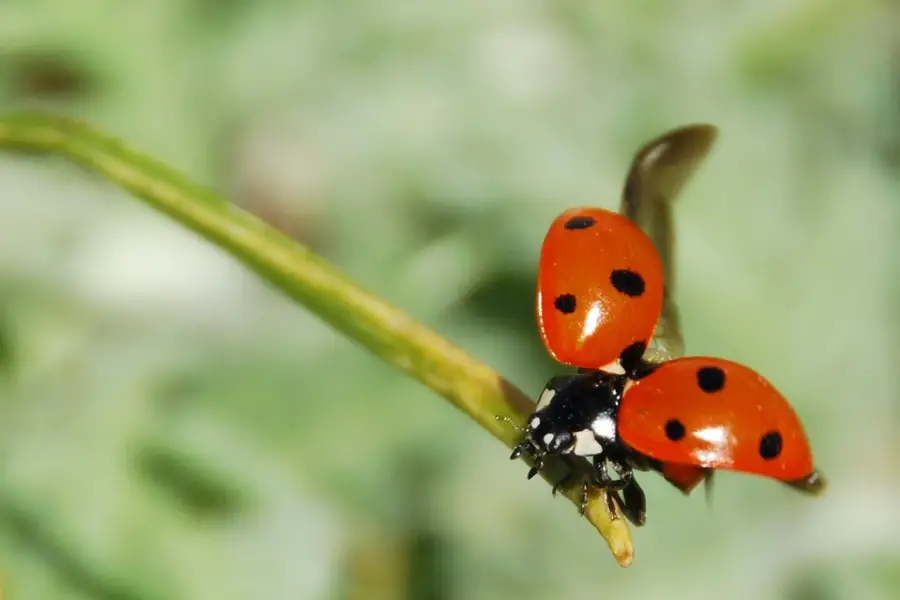
59. Are Green Ladybugs Poisonous?
Some Ladybugs are only poisonous to some other insects, so humans will never be poisoned by Ladybugs, unless they eat lots and lots of them, or if they have an allergy to them. As far as biting goes, all Ladybugs can bite, but mostly mistake us for food or as one of their forms of protection.
60. What Types of Bugs Do Ladybugs Eat?
Ladybugs mainly eat soft-bodied insects of smaller or equal size to themselves. Their favorite appears to be aphids, but they will hunt anything they think will provide a tasty meal. I’ve written a larger list of what Ladybugs eat as well as what eats ladybugs here.
61. What Are Ladybugs Enemies?
Despite their many defenses, there are still a number of predators of the Ladybug such as Dragonflies, including some birds such as Swallows. For a complete list of predators, see my list here of What Eats Ladybugs
Final Thoughts
So there it is, the full list…. So far!
There are some crossover answers in the list, but that’s down to the nature of each question, as some do have slightly different nuances to them that requires the answer to be rephrased in a different way. I hope you found it useful. As always, if I’ve missed a question you think should be answered, or you think it needs correcting then let me know.
If you’re an educator in a school or at home, do check out my resource page for lots of education resources freely available to download and use.
Also, don’t forget to check out my Ladybugs Guide article if you really want the full rundown on everything to do with Ladybugs. Also stop by my gifts and resources page where I’ve poured years of Ladybug shopping and finding into one helpful guide on buying the perfect Ladybug gifts, charms, symbols, and books.
Related Questions
Facts About Ladybugs. On the topic of Ladybugs, there are some amazing facts and strange things about Ladybugs that you probably never knew, or that no one ever told you about. If you want to know some amazing facts about Ladybugs then check out my post Surprising Facts About Ladybugs.

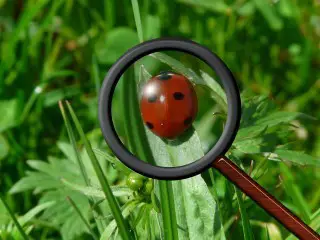


Need help cleaning up ladybug “poop”
Hi Helen, that can be difficult, Ladybug Poop can stain many surfaces, particularly porous surfaces. If you’re unable to remove them with traditional cleaning materials, then it may mean you’ll need to repaint, re-varnish etc surfaces that have been affected.
How long can a ladybug go without eating I just rescued one because I noticed him on the ceiling and didn’t want to kill it so waited till the next day but it didn’t move only couple inches was it dying or just hungry ? I put it in a bug cage and put lettuce and sugar and apple and it looks interested and went for it I will try and get proper food tomorrow and try and release it later this week
Hi, thanks for the comment, not sure where you’re located but if the temperature is below about 59F (15C) then they’re unlikely to fly, they could also be entering hibernation around this time of year and looking for a place to overwinter. When in diapause they don’t eat much if at all. Or, if the spots look faded then it might be an older ladybug in which case it may be nearing the end of its time. Perhaps read my article on How to tell if a Ladybug is dead, dying or hibernating Hope that helps!